Hose Connection Types: Tips For Choosing the Right One
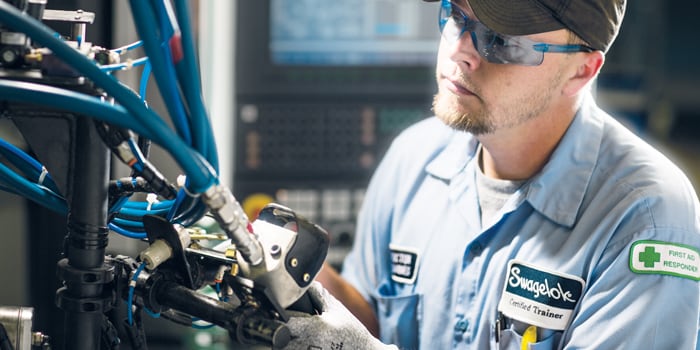
Tips for Choosing the Right Hose Connection

Industrial hoses play critical roles in facilities across the globe—but they often come with little guidance on useful best practices from the manufacturer. Hose selection, installation, inspection, and maintenance are commonly left up to the user or installer. And if the wrong choices are made, specified hoses have the potential to perform sub-optimally and can fail prematurely, which can lead to higher costs and possible safety hazards in your facility.
Your hose end connections provide a good example. There are a variety of flexible hose connection types to consider when designing your fluid system, and selecting the wrong type could undermine your process, put workers at risk, and compromise your bottom line. It is important to routinely review the performance of your end connections and consider if a different type could improve efficiency or quality in your system.
To keep workers safe and costs controlled, you need access to high-quality hoses available in a variety of materials and performance ratings, as well as insight on proper hose usage and upkeep. Unsure where to begin when selecting the right hose end connection for your needs? Consider the following three items: industry standards, hose type, and system specifications.
 Which Hose Connection Types are Standard for Your Industry?
Which Hose Connection Types are Standard for Your Industry?
Different industries require specific hose connection types designed to meet unique sanitation, purity or pressure standards is key to achieving and maintaining high performance in your fluid system. Below are some common industry uses and application specifications for end connections.
 Pharmaceutical, Biopharmaceutical, and Biotechnology Hose Connections
Pharmaceutical, Biopharmaceutical, and Biotechnology Hose Connections
In the pharmaceutical and biotechnology field, sanitation and hygiene are often of utmost importance when it comes to fluid system design. End connections used within this industry are designed with that in mind—they are more easily cleaned, either by taking the system apart for thorough cleaning or using a CIP (clean-in-place) process. Surfaces are designed to mitigate bacteria growth, and they are corrosion resistant.
 Semiconductor Industry Hose Specifications
Semiconductor Industry Hose Specifications
In the semiconductor manufacturing industry, material purity is typically the top priority for fluid system design. End connections used within the semiconductor market are high-purity for use in sensitive environments, with very fine threads, designed and coated with material to enhance resistance to buildup and contaminants.
 General Industrial Types of Hose Connector
General Industrial Types of Hose Connector
For many other industrial fluid system applications, design engineers are most concerned with the ability for end connections and fittings to perform under high pressure. These end connections are rated based on psi and sometimes require additional tube preparation to handle the pressure requirements.
Watch how to select hose end connections optimal for your process

How Do Hose Requirements Influence Connection Choice?
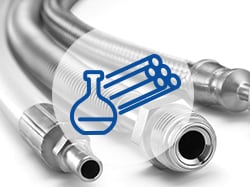
End connection and hose material requirements vary based on the corrosion risks and permeation needs of the application.
How Important are Permeation and Chemical Compatibility?
Finding the right hose materials to mitigate chemical reactions, system damage, or corrosion is critical. Hoses of any material are permeable to a degree, and each should be tested for application compatibility before use. Likewise, chemical compatibility (i.e., a lack of chemical reaction when two substances come into contact) is necessary for many fluid system applications.
How Do Pressure and Temperature Ratings Affect Hose Selection?
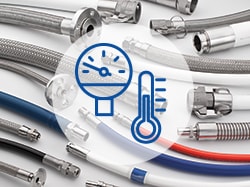
Depending on the application, fluid system components must be able to withstand specific pressures and temperatures. In high-pressure and high-temperature applications, like hydraulic systems and other general industrial applications, single- or double-braided annular hoses with a corrugated core tube are a common selection. High-pressure and high-temperature requirements often go hand-in-hand with dynamic applications in which a hose will need to flex, or change position, which can also impact hose selection.
Which Hose Material is Right for You?
Metal cores are a good choice for general needs, while silicone or fluoropolymers are generally preferred for sanitary applications. Metal core hoses are rated for temperatures between -325° and 850° F, which sometimes makes them the only material choice for extreme temperatures. Silicone, on the other hand, is a common choice for sanitary applications because of the material’s flexibility. However, silicone has limited chemical compatibility and is absorptive, which can lead to contamination. Because of silicone’s drawbacks, it is being replaced by fluoropolymer cores in sanitary applications. PTFE, PFA, and FEP are three common fluoropolymers, with slightly higher temperature ratings than silicone. Additionally, thermoplastic (nylon) hoses are commonly used in hydraulic applications because they can withstand high pressures, and rubber hoses are an economical, general purpose choice used mostly in low-pressure applications.

 How Do System Specifications Impact Selection?
How Do System Specifications Impact Selection?
The material and type of hose connection in your system should match the hose being connected. The material of the system and hose connection types should be the same. Many types of hose connections are similar in appearance, but they may have minor dimensional or thread differences—meaning they are not truly interchangeable.
Some other miscellaneous items to consider when selecting the proper hose end connection types:
- Ease of installation and/or permanence. How often will these end connections need to be replaced? How difficult will it be to replace them regularly, if needed?
- Inventory simplification. While fluid system performance, compatibility, and specifications are primary concerns when selecting hose connection types, it is smart to also consider the operational impact of your selections. Consider exploring how to store components more easily and how to streamline the reordering process, or how to consolidate vendors and component OEMs.
- Cost of your hose end connections. Cost is always a consideration when selecting components for your fluid system but remember to consider the lifetime cost of frequent replacements that could undermine the upfront savings of cheaper components.
Swagelok Product Selection Tools
Need additional assistance to select the correct hose end connection for your application? Swagelok offers a number of product selection tools available for use online, including:
Cv Calculator – for help calculating Cv and flow for regulators and other components
CAD Templates – more than one million Swagelok CAD templates and sales drawings in 2D and 3D file formats
Material Selection Guide – for help simplifying the selection of materials
The considerations for hose connection types above are not foolproof, however. It is up to the individual design engineer to evaluate the total fluid system design when selecting end connections and other components.
Related Hose Articles
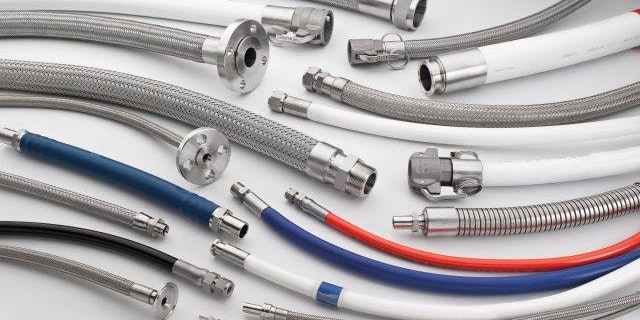
3 Steps to Hose Safety & Lower Plant Costs
Learn how to evaluate your systems and develop a preventive maintenance plan to manage the health of your hoses.
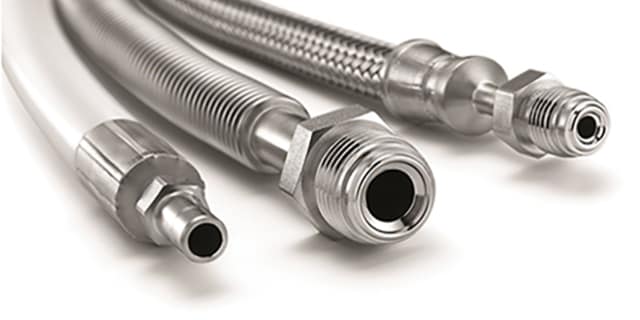
How an Industrial Hose Maintenance Plan Could Save Your Plant Thousands
Learn tips to avoid dangerous situations while lowering plant costs.
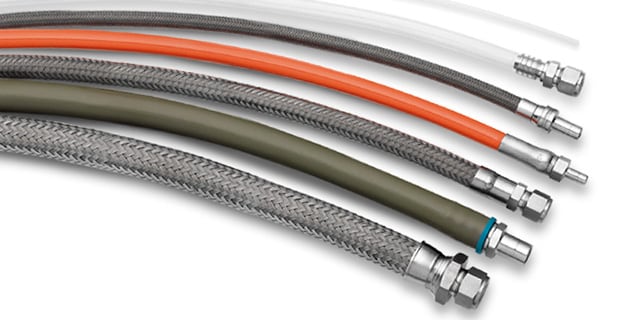
Industrial Hose Material: Core Tube Considerations
The right industrial hose keeps your fluid systems performing safely and effectively.

